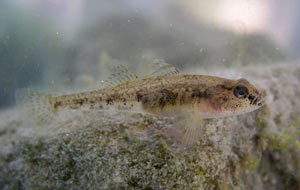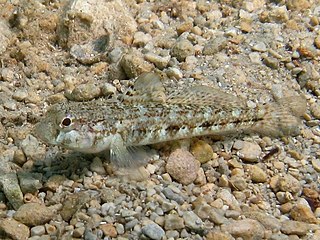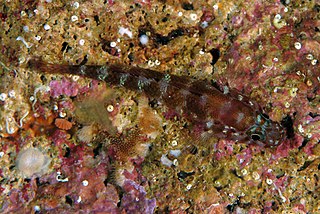Knipowitschia ephesi, the Ephesus goby, is a species of goby endemic to the delta and marshes of the lowermost Küçük Menderes in western Anatolia, Turkey.Turkey where it occurs in stagnant or nearly stagnant fresh waters. Its habitat is threatened by water abstraction, pollution, and destruction and these have an impact on this species, leading to the IUCN to classify it as Critically Endangered. The specific name refers to the ancient, ruined city of Ephesus which was a port located at mouth of the Küçük Menderes.

Knipowitschia panizzae, the Adriatic dwarf goby, is a species of goby native to the coasts of the Adriatic and Ionian Seas where it has been recorded in Italy, Slovenia and Croatia with records from Greece needing to be confirmed. It prefers fresh and brackish waters with plentiful vegetation. This species can reach a length of 5.5 centimetres (2.2 in) TL. It is not known who the specific name honours but it is thought likely to be the Italian anatomist Bartolomeo Panizza (1785-1867), who studied the post-reproductive mortality of male sea lampreys.

Pomatoschistus canestrinii, Canestrini's goby, is a species of goby native to fresh and brackish waters along the Adriatic coasts where it is known to occur from the Po delta, Italy to Neretva, Croatia. It has also been introduced in Lake Trasimeno, Italy. This species prefers areas with sand or mud substrates in lagoons, lakes and medium-sized to large-sized rivers. This species can reach a length of 5.5 centimetres (2.2 in) TL. The specific name honours the Italian biologist Giovanni Canestrini (1835-1900).

Pomatoschistus is a genus of gobies native to fresh, brackish and marine waters of Europe, the eastern Atlantic Ocean and the Mediterranean Sea.

Hector's goby is a species of goby native to the Indian Ocean to the islands of Micronesia in the western Pacific Ocean. It can be found on sheltered coral reefs at depths of from 3 to 30 metres. This species reaches a length of 8.5 centimetres (3.3 in) SL. It can also be found in the aquarium trade. The specific name honours Gordon Hector who was Chief Secretary to the Government of the Seychelles, in gratitude for his help to Smith's work in the Seychelles.

Fries's goby is a species of goby native to the Eastern Atlantic Ocean along the coasts of Europe and northern Africa as well as the Mediterranean Sea to the Sea of Marmara. This species burrows into muddy or muddy sand substrates at depths of from 10 to 130 metres and is frequently found in association with the Norway lobster Nephrops norvegicus. This species can reach a length of 13 centimetres (5.1 in) TL. The specific name honours the Swedish zoologist Bengt Fredrik Fries (1799-1839).
Neogobius pallasi, the Caspian sand goby or the Caspian monkey goby, is a species of fish native to fresh and brackish waters of the Caspian Sea basin including the Volga drainage up to the vicinity of Moscow. It has been introduced into the Aral basin. This species of goby can reach a length of 20 centimetres (7.9 in) SL. It is also important to local commercial fisheries.

Pomatoschistus bathi is a species of goby native to the eastern Mediterranean and the Sea of Marmara where it occurs at depths of from 7 to 14 metres on substrates with a sand or mud component. This species can reach a length of 3 centimetres (1.2 in) TL. It is found in Mediterranean Sea and Black Sea, with scattered records in southwestern France to Turkish Aegean Sea coast. The Bath's goby feeds on bosmiden, brine shrimps, lobster eggs, oyster eggs, zoobenthos and zooplankton. In 2013, it was listed as data deficient but was changed to Least Concern the following year because the population is thought to stable, it may be under-represented and there are no known threats. The specific name honours the German ichthyologist Hans Walter Bath (1924-2015).

Gobius kolombatovici is a species of goby native to the northern Adriatic Sea where it occurs at depths of from 15 to 38 metres in areas with patches of rock and softer sediments. This species can reach a length of 9.2 centimetres (3.6 in) SL. The specific name honours the Croatian mathematician, naturalist and taxonomist Juraj Kolombatovic (1843-1908), who carried out extensive work on the small inshore fishes of the Adriatic Sea.

Gobius roulei, Roule's goby, is a species of goby native to the eastern Atlantic Ocean and the Mediterranean Sea where it can be found at depths of from 320 to 385 metres. This species can reach a length of 8 centimetres (3.1 in) TL. The specific name honours the French zoologist Louis Roule (1861-1942) who was the collector of the type.

Couch's goby is a species of goby native to the northeastern Atlantic Ocean as far north as southern Great Britain and Ireland, the Mediterranean Sea and the Adriatic Sea where it can be found living under stones on muddy sand in inshore waters and in the intertidal zone. This species can reach a length of 7.7 centimetres (3.0 in) TL. The specific name and common name both honour Jonathan Couch (1789-1870), the Cornish ichthyologist and the author of A History of the Fishes of the British Islands published between 1862 and 1867.
Pomatoschistus tortonesei, Tortonese's goby, is a species of goby native to the Mediterranean Sea where it is known from Marsala, Sicily and the Farwah Lagoon in western Libya. This species occurs in shallow waters ranging in salinity from brackish to just slightly hypersaline. It prefers habitats with sandy substrates near to beds of seagrass. Its diet consists of small crustaceans and gastropods. It is threatened by the fragmentation and destruction of its preferred habitat by silting. The specific name honours the Italian zoologist Enrico Tortonése (1911-1987) of the Museo Civico di Storia Naturale di Genova.
Pomatoschistus lozanoi, Lozano's goby, is a species of goby native to the northeastern Atlantic Ocean from the North Sea to northwestern Spain and Portugal where it can be found at depths of from 70 to 80 metres. This species can reach a length of 8 centimetres (3.1 in) TL and is known to live for only two years. The specific name honours the Spanish zoologist Luis Lozano Rey (1878-1958).
Didogobius bentuvii, Ben-Tuvia's goby, is a species of goby native to the Mediterranean Sea along the coast of Israel where it can be found on muddy sand bottoms at around a depth of 37 metres (121 ft). Both the specific name and the common name honour the Israeli ichthyologist Adam Ben-Tuvia (1919-1999) of the Hebrew University of Jerusalem, who collected type and who has made a significant contribution to the knowledge of the Mediterranean fish fauna.

Didogobius schlieweni is a species of goby native to the Adriatic Sea. The specific name honours the German ichthyologist Ulrich Schliewen of the Zoologische Staatssammlung München in Munich, the collector of the type and who suggested that the species be given the common name Andromeda Goby referring to the "nebula-like pattern of light and dark markings".

Steinitz's goby is a species of goby. It is native to the Mediterranean Sea near Marseilles. It has been recently recorded in the Adriatic Sea in Croatia, Tyrrhenian Sea in Italy, and in the Black Sea in Ukraine. This species can be found in underwater grottoes in inshore waters at depths of 2 to 15 metres. Steinitz's goby can reach a length of 3.8 centimetres (1.5 in) SL. Its name honours the marine biologist and herpetologist Heinz Steinitz (1909-1971) of the Hebrew University, Jerusalem.
Ginsburgellus novemlineatus, the Nineline goby, is a species of goby native to tropical reefs of the western Atlantic Ocean and the Caribbean Sea. It is frequently found associated with the sea urchin Echinometra lucunter, living underneath the urchin. This species grows to a length of 2.5 centimetres (0.98 in) TL. This species can also be found in the aquarium trade. This species is the only known member of its genus, the name of which honours the ichthyologist Isaac Ginsburg (1886-1975) of the U.S. National Museum who had an interest in gobies.
Hyrcanogobius bergi, the Volga dwarf goby, is a species of goby endemic to the Caspian Sea where it occurs in fresh, brackish and marine waters along the coast. Unusually for gobies, this species is almost a pelagic fish. This species grows to a length of 3.6 centimetres (1.4 in) SL. This species is the only known member of its genus. The specific name honours the Soviet zoologist Lev Berg (1876-1950) who described many new species of goby from the Caspian Sea.
Ferrer's goby is a species of goby native to the Mediterranean Sea where it occurs in inshore waters inhabiting areas with sandy substrates. This species grows to a length of 3.5 centimetres (1.4 in) TL. This species is the only known member of its genus. The specific name honours Jaume Ferrer Aledo (1854-1956), a pharmacist and amateur ichthyologist who studied the fish fauna in the Balearic Islands.
Knipowitschia caunosi, the Caunos goby or Köycegiz dwarf goby, is a species of ray-finned fish from the family Gobiidae which is endemic to Lake Köycegiz in western Anatolia near the Aegean Sea. The lake is protected and the species is abundant within the lake so the IUCN have classified K. caunosi as Least Concern. The specific name references the mythological figure Caunos, who was the twin sister of Byblis, in legend his sister fell in love with him and he fled to avoid committing incest, founding the ancient city Kaunos in Caria, the ruins of which are situated on the southwest Anatolian coast; near to Lake Köycegiz.












